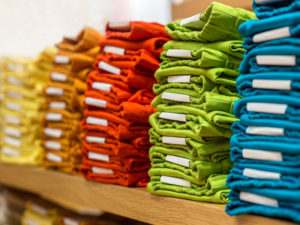
Resolute DTG’s managing director, Colin Marsh, provides some useful production tips for direct to garment printing and associated decoration methods.
Part of being a successful garment decorator is matching the best decoration method with the right garment, and if multiple decoration methods are offered, stock of blank garments can sometimes skew that perspective.
Let’s say your business has an embroidery machine, a vinyl cutter, a heat press, a DTG printer, a printer/cutter and some screen printing equipment. That’s the whole shooting match and you should be able to handle any orders no matter what they involve. But how do you decide which method to use? Sometimes it’s based on the price the customer wants to pay, sometimes on the quantity the customer wants to order. The option may also hinge on the quality the customer wants to see. And other times your choice may be forced based on the time in which a customer needs the job. That’s a lot of variables, but as you have all the right kit what could go wrong?
If you don’t have sufficient stock levels of the required consumable and the items to be decorated the production time for your job will be longer, even worse your deadline could be missed. It’s not uncommon for customers to wait until the week and sometimes even the day before an event to place their order. What to do? Production is consistently tied to two factors: inventory and capacity. Capacity is how much can get done in a shift or a day on any given piece of equipment. Adding capacity is significantly more expensive than controlling stock levels, extra capacity means increasing productivity by adding people, equipment or hours of the day. Controlling your entire inventory means having what’s needed on hand so as not to waste any of the capacity you already have in place.
Your DTG print orders aren’t going to fly out of the door without sufficient ink and pre-treatment on the shelf ready to use. If you have the ink to hand your next pitfall could be not having the garments to print. Not rocket science I know but what can be done to prevent a warehouse full of blanks and litres of ink being racked up on the shelf.
Checkout your options for supplies, in today’s internet driven world with a little research you should find suppliers that not only offer next day delivery, they offer multiple products allowing for one shipping fee and if your spending enough that shipping could be free with the added benefit of being in the morning, not any time of the day.
Likewise, you should keep some common items to hand as some orders could be required the same day. These you can charge a premium for and can sway the customer’s choices as it’s a same day deadline. So all in all, we get to try and foretell the future. What is the customer going to want? Here are some helpful clues in predicting:
School colours
If you have a local primary or secondary school checkout their preferred colours, stock some of these covering all methods. Common garments, hoodies, tees etc, vinyl and the required thread colours if you embroider. Plan to offer a limited range but one they will be happy with as you are almost guaranteed to get urgent orders from schools. Having a few samples of what you can produce quickly to hand will impress and build confidence with your client.
Variable data
This is the ability to personalise with variable data. If you can DTG print on demand, you only have to stock printable garments. Offer names, numbers, sayings, custom images, custom fills… anything that sets an item apart. DTG can handle all of these with ease, providing you can command the right price DTG is your best option here. If price is an issue you could drop back to vinyl but this will reduce the colours you can offer and the overall look of the garment.
Expertise and guidance
Going back to the point about samples, remember that you are the expert and your customer is looking to you for guidance. The expectation you set can make or break that customer’s experience with you. Make sure you only show what is achievable in the required deadline and you’ve cracked it. As scary as the word inventory can be, it can also be as easy as communicating the proper expectations to your customers.
 Printwear & Promotion The Total Promotional Package
Printwear & Promotion The Total Promotional Package




